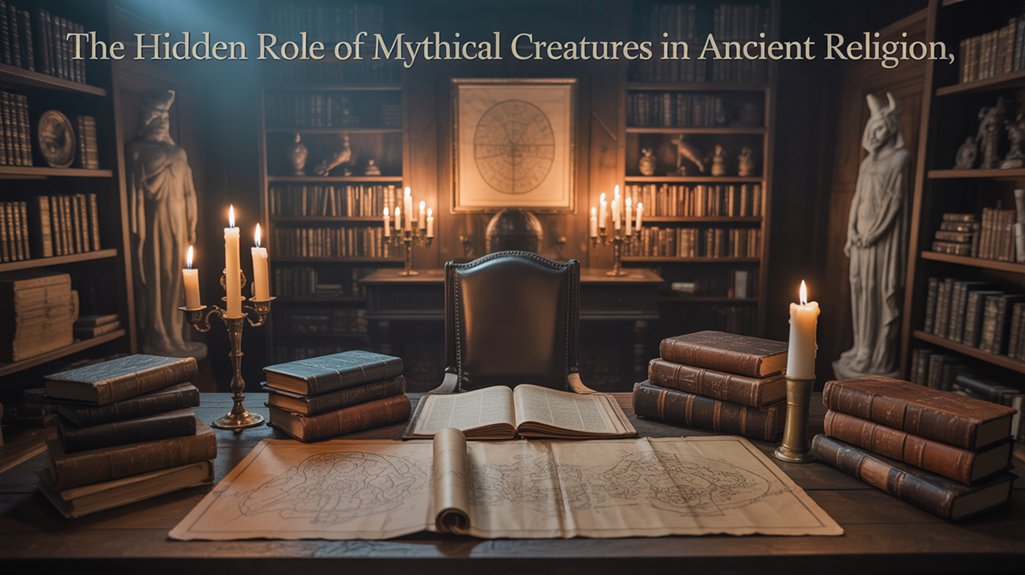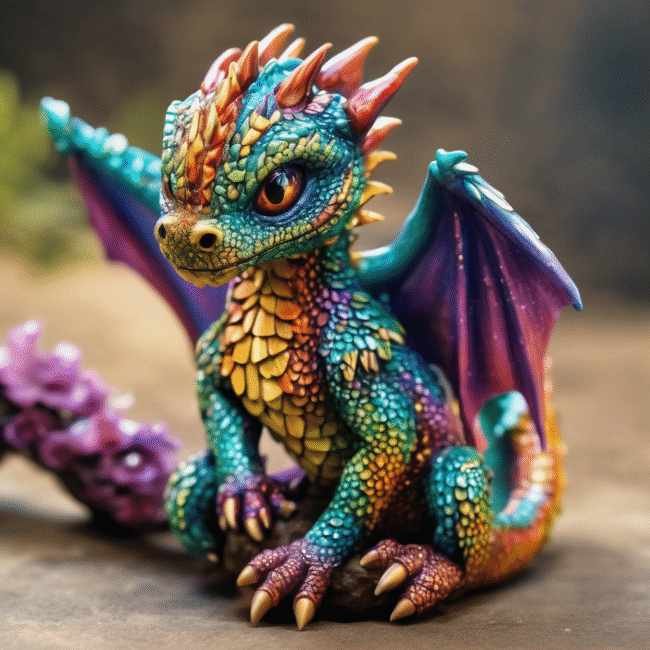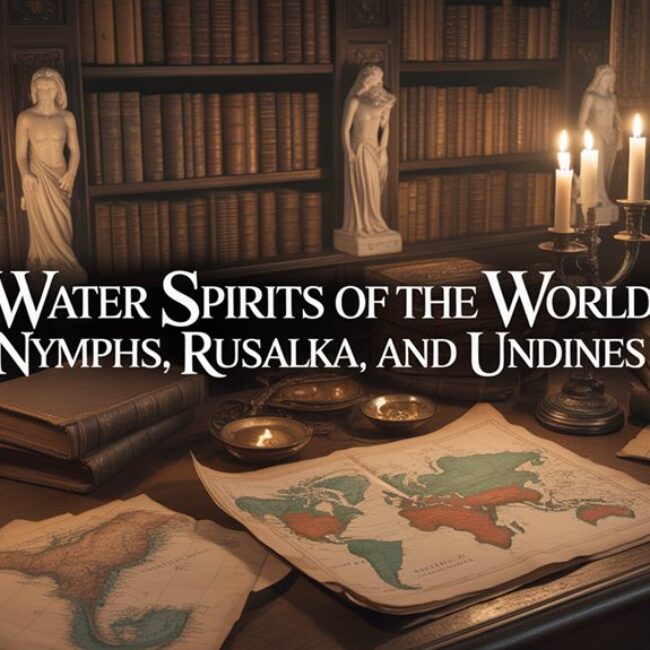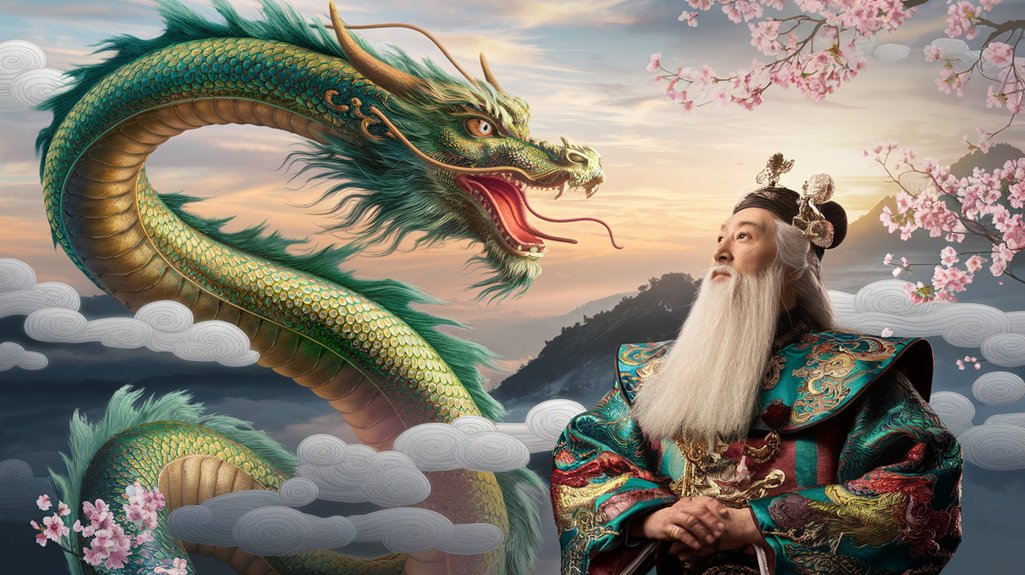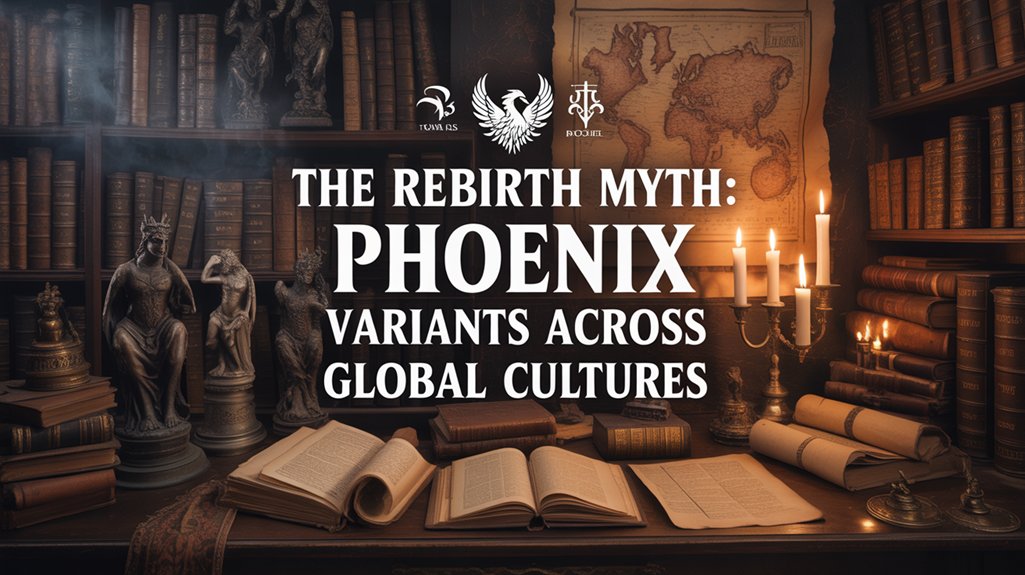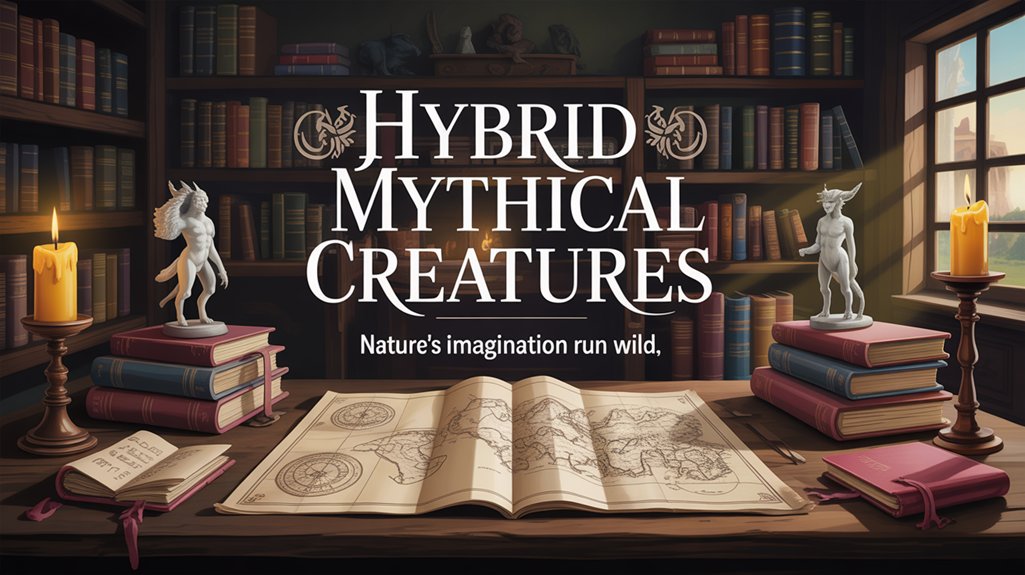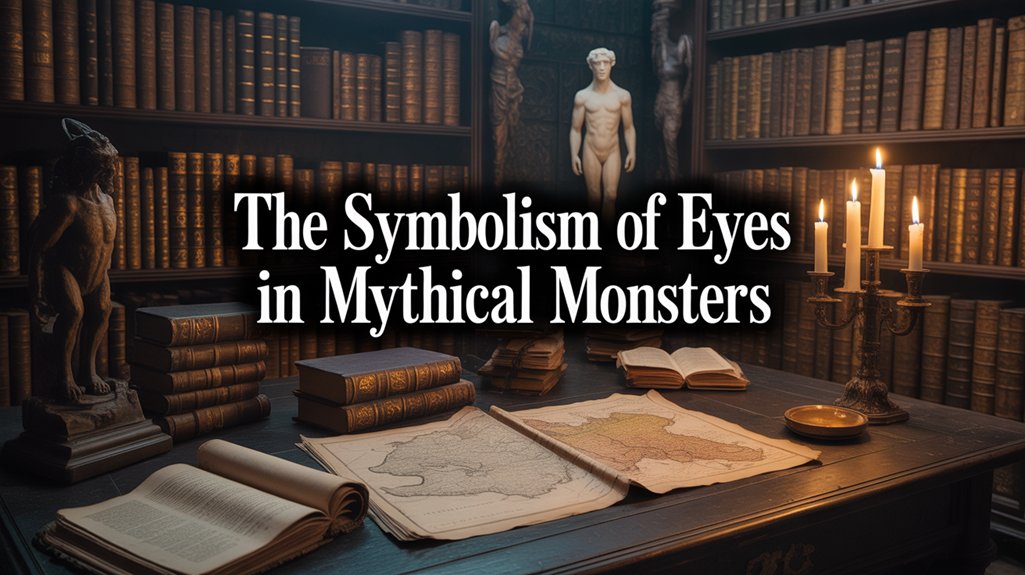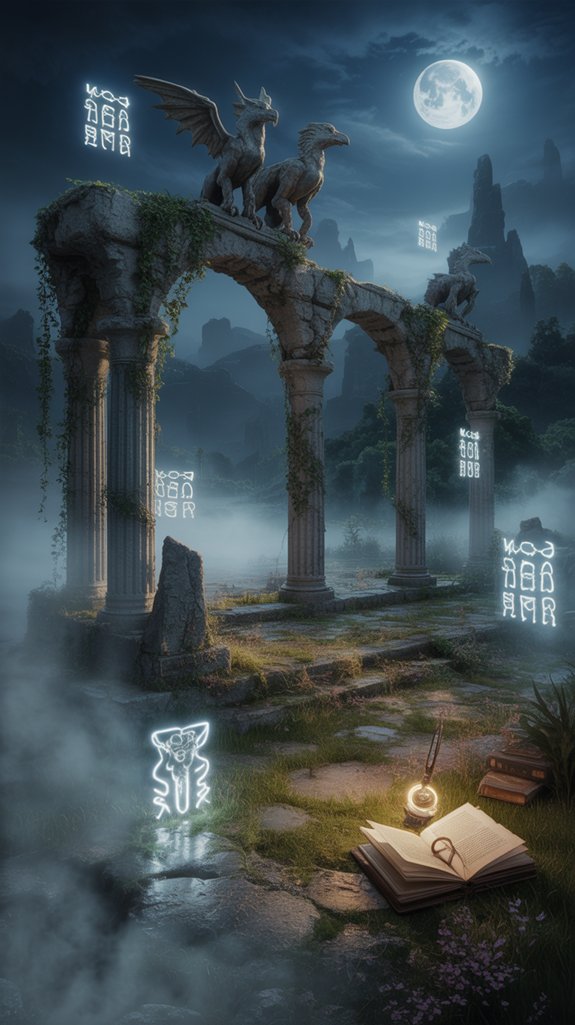
Mythical creatures weren’t mere decoration—they formed ancient religion’s theological infrastructure, converting abstract divine principles into tangible regulatory forces. You’ll find sphinxes stationed at temple thresholds as sentient barriers, Ammit’s chimeric form maintaining cosmic balance at Ma’at’s scales, and Apep coiling through primordial chaos against Ra’s solar barque. These beings occupied liminal spaces where civilization met disorder, mortality encountered transcendence, profane converted into sacred. From predynastic petroglyphs to daily temple rituals involving ceremonial spearings of wax serpents, hybrid guardians enforced boundaries that sustained cosmic order across every ancient civilization—a spiritual architecture whose resonance echoes through modern archetypes.
Table of Contents
ToggleKey Takeaways
- Mythical creatures served as guardians of sacred boundaries, marking transitions between mundane and divine realms in temple architecture and cosmology.
- Hybrid beings embodied divine forces and acted as mediators, bridging mortal existence with celestial domains through their chimeric forms.
- Creatures functioned as active participants in rituals, with priests performing ceremonies to combat chaos and maintain cosmic order through symbolic combat.
- Pre-state societies used animal petroglyphs as theological arguments, negotiating with forces governing fertility, rainfall, and natural cycles through offerings.
- Serpentine deities represented cosmic tensions across cultures, embodying chaos versus order and serving as existential warnings about maintaining universal balance.
Creatures Beyond Temple Walls
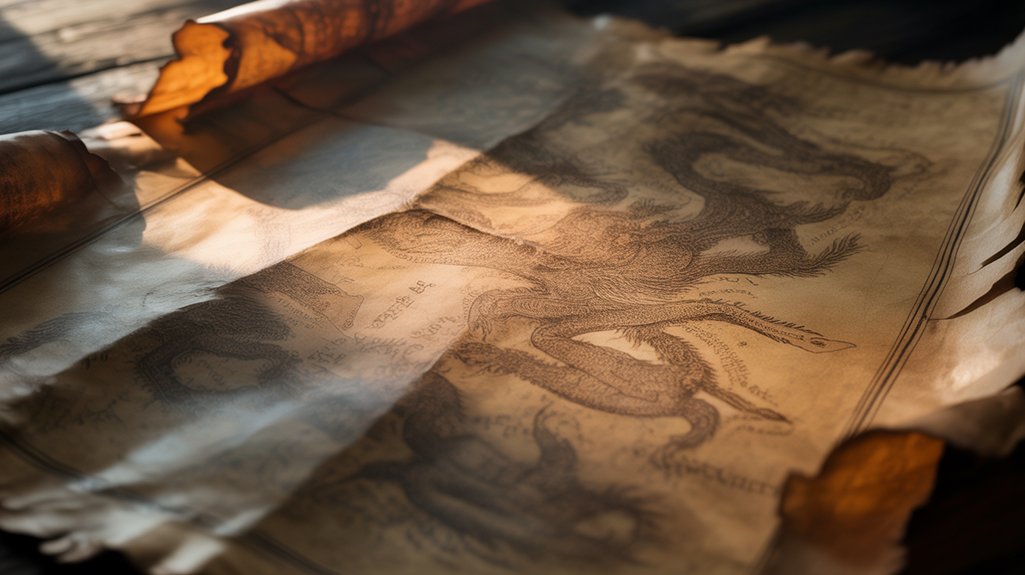
While temple precincts contained the formalized worship of Egypt’s pantheon, the truly eldritch beings—those chimeric amalgamations of flesh, scale, and divine purpose—prowled the liminal spaces where civilization met chaos.
You’ll find Ammit waiting at the scales of Ma’at, devouring hearts weighed against feathers. Apep coiled in darkness beyond Ra’s solar barque. These weren’t mere temple decorations.
Mythical interactions shaped daily existence profoundly. The serpopard embodied foreign threats lurking beyond borders, reminding you that chaos perpetually tested ma’at’s fragile order.
Griffins and sphinxes guarded thresholds—stone sentinels marking changes between mundane and sacred. Even the oxyrhynchus fish swimming through Hathor’s waters demonstrated how divinity saturated ordinary life, altering riverine sustenance into theological statement.
El Naddaha’s folklore reveals how these beings enforced social morals outside priestly authority. Her Nilotic seductions warned against unchecked desire, teaching lessons through terror rather than scripture.
The sacred and profane merged completely, mythical creatures becoming society’s conscience incarnate.
##
You’ll find that mythical creatures didn’t merely inhabit temples—they patrolled the thresholds between sacred and profane, their chimeric forms stationed at doorways, tomb entrances, and ritual boundaries where cosmic order demanded vigilant enforcement.
These eldritch guardians embodied divine forces themselves, converting abstract theological concepts into tangible presences that both protected and threatened, their dual nature reflecting the ancient Egyptian understanding that power and danger were inseparable.
Through their positioning at liminal spaces, these beings served as mediators, translating the incomprehensible will of gods into forms mortals could witness, fear, and ultimately, petition through carefully prescribed ritual practice.
Guardians of Sacred Boundaries
Throughout ancient civilizations, mythical creatures didn’t merely ornament religious architecture—they stood as sentient barriers between territories, their chimeric forms channeling divine power through stone and symbol.
You’ll find the Sphinx positioned at temple thresholds, its leonine body merged with human wisdom to repel malevolent forces.
Guardian symbolism reached its apex in the Uraeus—that rearing cobra adorning pharaonic crowns, altering rulers into living conduits of protection.
The Hieracosphinx embodied Horus himself, hawk-headed sentinel bridging mortal and celestial domains.
These mythical protectors enforced cosmic order: Ammit devoured corrupted souls at judgment’s threshold, while Griffins stood vigil over sacred treasures.
Each creature marked boundaries you weren’t meant to cross—unless deemed worthy by forces beyond human comprehension.
Similarly, Black Dogs from European folklore served as spectral guardians of crossroads and sacred sites, their nocturnal presence warning travelers of supernatural thresholds.
Embodiments of Divine Forces
Beyond their sentinel duties, these chimeric beings channeled the very essence of cosmic powers—becoming living vessels through which divine forces manifested in material form.
You’ll find Ammit devouring unworthy souls, maintaining divine balance through her crocodile jaws, lion’s torso, and hippopotamus hindquarters. Pure chaos embodiment.
Apep, the serpentine nemesis, coiled eternally against Ra’s solar barque, representing primordial disorder threatening creation itself.
The Bennu rose phoenix-like from Heliopolis’s sacred flames, its cyclical death and resurrection mirroring cosmic renewal.
Khepri rolled the sun-disk across heaven’s vault, the scarab’s mundane dung-pushing altered into celestial mechanics.
These entities weren’t mere symbols—they were eldritch conduits where metaphysical principles achieved corporeal expression, where abstract concepts of alteration, destruction, and regeneration took breathing, terrifying, magnificent shape within Egypt’s sacred cosmology. Like the Wendigo of Algonquin lore, these creatures embodied humanity’s deepest terrors, transforming abstract fears into tangible divine warnings that demanded reverence and ritual appeasement.
Mediators Between Mortal Realms
Where divine will met mortal necessity, these liminal entities established themselves as essential bridges—creatures neither fully celestial nor earthly who negotiated the treacherous boundaries between cosmic hierarchy and human experience.
You’ll find spiritual messengers like Aani, Thoth’s sacred baboon, escorting souls through shadowed afterlife passages, their eldritch wisdom illuminating paths between existence and oblivion.
The Bennu embodied cyclical metamorphosis—death bleeding into resurrection, endings becoming beginnings.
These divine intermediaries didn’t merely transmit messages; they *became* the transmission itself.
Apep’s serpentine chaos demanded Ra’s cosmic intervention, while the Uraeus coiled protectively around pharaonic crowns, converting monarchs into living conduits of divine authority.
Such chimeric beings operated within charged thresholds where mortality trembled before eternity’s weight, where you’d witness the sacred made tangible through scaled skin and feathered form.
Symbols in Ritual Practice
These intermediary beings transcended mere theological abstraction—their forms crystallized into tangible symbols that priests manipulated, wore, and invoked within ceremonial spaces charged with numinous power.
You witness this alteration most dramatically in Egypt’s Uraeus, that serpentine emblem of sovereignty worn upon pharaonic brows, channeling divine protection against primordial chaos.
The Greeks understood this principle equally well, depicting Dionysus with chimeric bull attributes, his mythical representations binding worshippers to agricultural cycles and fertility’s sacred rhythms.
Divine symbolism achieved architectural permanence through guardians like the Sphinx, its leonine-human form standing sentinel at temple thresholds.
Even Ammit’s eldritch crocodilian jaws served ritualistic purpose—her fearsome visage demanding offerings, her presence modifying ceremonies into moments of profound moral reckoning.
These weren’t decorative flourishes. Sacred technology.
Predynastic Egyptian Animal Petroglyphs

You’ll find the Naqada II Period (circa 3500-3200 BCE) marks a threshold moment when Upper Egypt’s rock faces became canvases for something profoundly eldritch—hybrid forms merging human consciousness with animal power, etched across the limestone cliffs stretching from Thebes to Nubia’s borderlands.
These weren’t mere decorative exercises. They capture pre-state formation belief systems in their raw, chimeric intensity: communities who understood divinity through the gazelle’s leap, the bull’s strength, the serpent’s wisdom, all rendered in ochre and percussion before pharaohs walked the earth.
Naqada II Period Imagery
The serpentine Nile carved more than geography into the consciousness of Predynastic Egypt—it inscribed a covenant between flesh and spirit that would manifest most powerfully during the Naqada II period (3500-3200 BCE), when artisans struck stone with unprecedented fervor to capture the numinous essence of creatures both terrestrial and chimeric.
You’ll find leopards prowling across rock faces, their spotted forms merging with crocodilian features in eldritch configurations that defied natural taxonomy. This Naqada II symbolism wasn’t mere decoration—it represented cosmological architecture.
Ancient Egyptian mythology crystallized here, in funerary contexts where hybrid beings guarded the threshold between mortality and transcendence. Birds soared alongside serpents, their combined forms encoding protection, power, divinity.
These petroglyphs established visual vocabularies that would later dominate temple walls and tomb chambers throughout pharaonic civilization.
Upper Egypt and Nubia
Stone witnesses endure where papyrus perished—across the sun-scorched cliffs of Upper Egypt and the granite outcrops of Nubia, Predynastic artisans (circa 4000-3100 BCE) inscribed their spiritual cosmology through animal petroglyphs that functioned as threshold markers between the profane and sacred domains. You’ll discover predynastic symbolism etched into rock faces, where ancient wildlife transcends mere representation to become totemic conduits of power.
| Creature Depicted | Symbolic Function | Mythological Legacy |
|---|---|---|
| Cattle | Fertility, sustenance | Agricultural deities |
| Lions | Strength, sovereignty | Sekhmet’s ferocity |
| Crocodiles | Chaos, protection | Sobek’s dual nature |
| Ibises | Wisdom, passage | Thoth’s knowledge |
Hunting scenes reveal ritualistic intent—eldritch ceremonies ensuring successful kills. These images weren’t decorative. They were incantations carved in stone, binding humanity to the chimeric forces governing survival and transcendence.
Pre-state Formation Belief Systems
Before pharaohs consolidated divine authority into hierarchical pantheons, disparate clans across Egypt’s southwestern desert zones articulated their cosmological anxieties through petroglyphic vocabularies—chiseling hybrid forms into sandstone canvases that collapsed distinctions between corporeal and numinous domains.
You’ll find lions, crocodiles, and raptors merged with human anatomy in these eldritch configurations, each chimeric figure encoding spiritual symbolism that recognized nature’s autonomous sovereignty.
These weren’t decorative flourishes. They were offerings, ritualistic negotiations with forces governing rainfall, fertility, predation. The animal representations functioned as theological arguments: acknowledging power beyond human control while claiming kinship with it.
Through these carvings, pre-state communities constructed belief systems unmediated by priestly hierarchies or centralized dogma—direct, visceral engagements with a cosmos where divinity prowled, slithered, soared.
Pure animistic democracy.
Regional Serpent Deity Distinctions

Across disparate civilizations separated by vast oceans and millennia, serpentine deities emerged as primordial forces embodying fundamental cosmic tensions—chaos and order, destruction and renewal, drought and deluge. You’ll discover how serpent symbolism transcended geographical boundaries, yet cultural interpretations remained distinctly localized, shaped by environmental pressures and societal needs.
| Deity | Cultural Origin |
|---|---|
| Apep | Egyptian—chaos incarnate, Ra’s eldritch nemesis |
| Quetzalcoatl | Mesoamerican—feathered chimeric creator-destroyer |
| Vasuki | Hindu—cosmic balance, churning oceanic immortality |
| Jörmungandr | Norse—world-encircling harbinger of Ragnarök |
| Chinese Dragon | East Asian—benevolent water-guardian, agricultural protector |
Each manifestation reflected profound environmental relationships. Egyptian desert dwellers feared serpentine chaos threatening solar order. Mesoamericans revered dual-natured fertility bringers. Hindu tradition positioned serpents as mediators between mortality and transcendence. Norse cosmology saw apocalyptic potential coiled around existence itself. Chinese civilization adapted serpentine imagery into protective abundance. These weren’t mere mythological curiosities—they represented sophisticated theological frameworks interpreting humanity’s relationship with ungovernable natural forces.
Apep’s Nightly Solar Battle
Through the suffocating darkness of the Duat—Egypt’s labyrinthine underworld—Ra’s solar barque navigated twelve perilous hours each night. There, coiled within the seventh hour’s deepest abyss, Apep waited. This eldritch serpent, stretching across impossible distances, embodied primordial chaos itself.
In Duat’s seventh hour, the chaos-serpent Apep coiled eternally, waiting to devour Ra’s light and swallow cosmic order whole.
You’d witness priests performing hourly rituals, their incantations binding the chaos-wyrm while Ra’s defenders—Set, Mehen, Bastet—fought desperately to preserve cosmic balance.
Apep’s Nightly Assault:
- *The serpent’s maw yawning wide enough to swallow stars, darkness bleeding from between fangs that could crush mountains*
- *Ra’s solar disk dimming as Apep’s coils constricted the barque, threatening eternal night*
- *Magical harpoons piercing scaled flesh as defender-gods battled the thrashing chaos-beast*
Apep’s symbolism transcended simple evil—he represented entropy’s constant pressure against Ma’at’s ordered universe. Each dawn proved Ra’s victory, yet Apep couldn’t die. He’d regenerate. Return. Forever threatening.
This eternal struggle defined existence itself.
Apophis Ritual Destruction Ceremonies
You’ll find that ancient Egyptian temples became battlegrounds against eldritch chaos each dawn, where priests enacted elaborate destruction ceremonies to annihilate Apophis through daily ritualized violence.
These sacred performances—punctuated by incantations drawn from funerary texts, the burning of serpent effigies, and ceremonial spearings of wax figures—transformed temple precincts into cosmic theaters where order’s triumph required constant, vigilant renewal.
The hieratic words spoken against the chimeric serpent weren’t mere supplications but performative weapons, each syllable a binding force meant to shatter chaos itself before Ra’s barque could emerge victorious from the netherworld’s treacherous waters.
Daily Temple Ritual Performance
As dawn fractured the primordial darkness over the Nile Valley, temple priests gathered in sacred precincts to enact one of Egypt’s most essential liturgical performances—the ritual destruction of Apep, that eldritch serpent whose coils threatened to strangle Ra’s solar barque before it could breach the eastern horizon.
You’d witness these officiants, draped in ceremonial regalia, reciting spells from papyri while manipulating wax effigies of the chaos-beast.
Temple rituals weren’t mere symbolic gestures—they were existential necessities. Each incantation, each ritual blow struck against Apep’s representation, actively maintained cosmic balance against entropy’s advance.
Through these daily performances, priests became humanity’s defensive bulwark, ensuring Ra’s resurrection and preventing disorder from consuming creation itself.
The ceremonies embodied freedom’s ultimate expression: conscious resistance against cosmic tyranny.
Symbolic Serpent Annihilation Acts
When temple scribes committed the serpent-destruction liturgies to papyrus, they weren’t composing theological abstractions—they were encoding battle instructions for humanity’s most essential war.
You’ll find within the “Book of the Dead” explicit protocols for confronting Apep, whose serpent symbolism embodied primordial disorder threatening solar rebirth. Each ceremonial weapon thrust, each effigy’s ritual dismemberment, enacted cosmic triumph over chaos representation—your ancestors understood these weren’t mere performances but actualizations of divine combat.
The wielded blades, the chanted formulae, the community’s collective will changed into metaphysical arsenal. Ra’s nocturnal journey demanded your participation. Agricultural prosperity, social harmony, afterlife passage—all hinged upon these eldritch ceremonies.
Through symbolic annihilation, you maintained ma’at against the chimeric void, liberating existence itself from serpentine dissolution. Dawn required destruction. Always.
Priestly Incantations Against Chaos
Before dawn fractured the eastern horizon, Egypt’s ritual specialists assembled in temple sanctuaries to wage linguistic warfare against cosmic dissolution.
You’d witness these priests wielding priestly spells as weapons—carefully memorized incantations designed to bind Apep’s eldritch coils before the serpent could devour Ra’s solar barque. This chaos combat wasn’t theatrical performance but essential maintenance of ma’at, cosmic balance teetering perpetually toward collapse.
The specialists destroyed wax effigies, trampled papyrus serpents, spat upon clay representations while reciting words of power that resonated through temple columns.
During New Year festivals, these ceremonies intensified. The pharaoh’s survival, the Nile’s flooding, the harvest’s abundance—all depended upon successfully vanquishing this chimeric manifestation of primordial disorder.
Ancient Egypt understood what you’re only rediscovering: language possesses tangible force against entropy’s relentless advance.
Hollywood’s Ammit and Apep
Hollywood’s metamorphosis of ancient Egyptian mythology into cinematic spectacle has thrust Ammit and Apep—creatures once confined to papyrus scrolls and temple walls—into the collective consciousness of modern audiences.
Ammit’s portrayal alters her chimeric form—lion’s mane, hippopotamus torso, crocodile jaws—into visceral judgment incarnate, where souls weigh heavy with consequence. She becomes both guardian and executioner, her eldritch presence reminding viewers that actions echo beyond mortality’s threshold.
Chimeric judge of souls—lion, hippo, crocodile fused—Ammit devours those whose hearts fail Ma’at’s feather, making mortality’s consequences eternal.
Apep’s symbolism channels primordial chaos, the serpent coiling through darkness to challenge Ra’s solar barque. Contemporary adaptations amplify this cosmic struggle:
- *Scales glistening with void-darkness, swallowing light itself*
- *Fanged maws stretching wide enough to consume entire worlds*
- *Coils writhing through dimensional boundaries, chaos bleeding into order*
These creatures transcend mere entertainment. They resurrect ancient questions about moral weight and cosmic equilibrium.
You witness humanity’s perpetual fascination with judgment, chaos, and the liminal space where free will confronts universal consequence—themes that demanded reverence in pharaonic temples and demand contemplation in modern theaters.
Jung’s Archetypal Shadow Analysis
Though ancient civilizations lacked Jung’s twentieth-century terminology, they intuitively grasped what the Swiss psychoanalyst would later codify as the shadow archetype—that repository of rejected traits, suppressed urges, and unacknowledged darkness dwelling beneath consciousness’s luminous surface.
When you examine Apep’s serpentine coils strangling Ra’s solar barque, you’re witnessing shadow integration through mythical storytelling—a collective confrontation with chaos that predates modern psychology by millennia.
Ammit embodies this process completely. The chimeric devourer, positioned at Ma’at’s scales in the Duat’s judgment hall, consumed hearts weighted with unconfessed deeds.
You weren’t meant to banish your shadow. You were meant to acknowledge it, integrate it, change it through sacred narrative before death forced the reckoning. These eldritch beings served as mirrors, reflecting humanity’s suppressed violence, greed, and disorder back through ritual and temple art.
The Egyptians understood what you’re only rediscovering: freedom demands embracing your complete self, shadows included.
Environmental Crisis Symbolism Today
While Apep’s chaos once manifested as cosmic serpents threatening solar rebirth, today’s mythical frameworks resurrect themselves through environmental catastrophe—water spirits choking on industrial effluent, river deities retreating from poisoned banks, ancient warnings encoded in folklore suddenly translating into climate data.
You’ll recognize El Naddaha’s lament echoing through contaminated waterways, her chimeric form dissolving as rivers blacken. Environmental folklore evolves from cautionary whisper to prophetic scream. The giants who once defiled sacred springs? They’re petrochemical conglomerates.
Folklore’s whispers amplify into warnings—mythical guardians retreat as industrial giants poison their sacred waters, translating ancient reverence into modern catastrophe.
Water nymphs demanding ecological reverence before consummating human bonds? They’re withdrawing consent entirely.
This mythical symbolism pulses with urgency you can’t dismiss as superstition. The serpent’s chaos isn’t metaphorical anymore—it’s measurable in parts per million, visible in eldritch algae blooms, tangible in collapsing ecosystems.
Ancient cultures embedded environmental wisdom within their pantheons, understanding what you’re relearning: nature’s balance isn’t negotiable. Disrespect water spirits, and they vanish. Simple. Fatal. True.
Creatures’ Enduring Spiritual Resonance
Because mythical creatures transcend their original cultural contexts to inhabit contemporary spiritual consciousness, they’ve achieved something ancient priests couldn’t anticipate: immortality through adaptation.
You’ll find Apep’s chaos coiling through modern tarot interpretations, the Sphinx’s riddles echoing in psychological archetypes, the Bennu’s rebirth manifesting in phoenix tattoos worn as talismans against despair. This mythical symbolism persists because it addresses unchanging human conditions—fear, change, protection.
These chimeric forms continue shaping spiritual beliefs across continents. The hieracosphinx’s hybrid nature speaks to your own multiplicity, your struggle reconciling animal instinct with rational thought.
Ancient amulets featuring serpopards and scarabs protected their bearers from eldritch forces; today’s practitioners commission similar tokens, recognizing that cosmic principles remain constant even as civilizations crumble.
The creatures haven’t died. They’ve evolved, maintaining their sacred function while shedding outdated cultural shells, proving that authentic spiritual resonance transcends temporal boundaries, speaking directly to your soul’s primordial vocabulary.
Frequently Asked Questions
How Did Ancient Priests Select Which Mythical Creatures to Include in Religious Texts?
You’ll find ancient priests employed rigorous priestly criteria, selecting beings whose creature symbolism resonated with cosmic truths they’d witnessed in temple mysteries.
They chose chimeric forms—griffins, nagas, phoenixes—that embodied specific divine principles: alteration, protection, cyclical rebirth.
These weren’t arbitrary selections but deliberate theological choices, each eldritch entity representing gateways between mortal and sacred domains.
The priests documented only those creatures whose symbolic power could liberate consciousness, granting you freedom through understanding primal forces.
Were There Mythical Creatures That Were Worshipped but Left No Archaeological Evidence?
You’d think legendary beings need monuments to prove their existence—yet the most potent worship practices often left no trace. Oral traditions carried eldritch entities through generations without stone temples or carved idols.
Consider chimeric spirits of nomadic peoples: their devotion manifested through dance, song, ephemeral offerings consumed by fire. These practices vanished like smoke, liberating ancient believers from material constraints while simultaneously erasing archaeological proof of their profound spiritual communion with the unseen.
Did Common People Have Different Beliefs About These Creatures Than Religious Elites?
You’ll find popular beliefs often embraced chimeric beings as tangible protectors—visceral, immediate, dwelling in sacred groves and mountain caves.
Religious elites, conversely, codified these entities through complex theological frameworks, altering raw numinous encounters into structured religious interpretations.
Common folk worshipped through direct offering and petition, seeking harvest blessings, healing.
The priesthood systematized cosmologies, hierarchies of divine beings.
This tension created layered mythologies: earthy folk traditions beneath eldritch theological constructs.
Two truths, coexisting.
How Did Ancient Religions Determine Which Creatures Were Good Versus Evil?
You’ll find ancient cultures didn’t trap themselves in binary thinking—that’s modern conditioning.
Good versus evil emerged through creature symbolism rooted in lived experience: serpents embodied both healing (Asclepius’s staff, 400 BCE Greece) and chaos (Apophis devouring Ra’s solar barque).
The chimeric and eldritch reflected humanity’s relationship with nature’s power.
Desert scorpions became malevolent; life-giving bulls, sacred.
You’re witnessing practical wisdom, not arbitrary judgment.
Survival shaped divinity.
What Role Did Mythical Creatures Play in Ancient Funerary Practices and Afterlife Beliefs?
You’ll find mythical creatures served as psychopomps—guides traversing liminal thresholds between worlds.
Egyptian Ba-birds bore souls skyward, while Mesopotamian scorpion-men guarded Shamash’s mountain gates.
These chimeric guardians weren’t mere decoration; they embodied metamorphosis itself.
Through funerary rites incorporating sphinx imagery, griffin motifs on sarcophagi, and eldritch serpent symbolism, you accessed protective forces.
The ancients understood: mythical symbolism in burial practices wasn’t superstition but sacred technology, liberating consciousness from corporeal bounds into eternal domains.
Conclusion
You’ve witnessed how these eldritch beings transcend mere mythology—they’re humanity’s oldest psychological mirrors. Consider this: over 80% of ancient civilizations developed serpent deities independently, suggesting Jung’s collective unconscious isn’t academic abstraction but observable reality. Today’s environmental crises resurrect Apep’s chaos, Ammit’s judgment. You can’t dismiss these chimeric forms as superstition when they’ve shaped human consciousness for millennia. They’re archetypal blueprints, dwelling in that liminal space where ancient wisdom meets contemporary reckoning. Their resonance endures.

